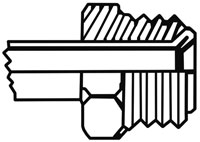| If you are adapting to an existing plumbing system, at some point you will probably need to order plumbing adapter fittings to connect tubing or hose to a threaded fitting in the original system. For the connection to be secure and leak-free, you need to select the adapter fitting with the correct thread size, but also the correct sealing flare type. With all of the adapter fittings we offer, this might seem like a complicated ordeal. In reality, you only need to identify 2 features of the fitting, and each is a simple, either-or choice. |
Male vs Female
Let's start with the easy one. Do you need a male fitting or a female fitting?
Tip: The terms Male and Female always refer to the threads on the fitting.
Which is which? Male threads are on the outside, like a bolt. Female threads are on the inside, like a nut. The male threads screw into the female threads.
This sometimes leads to confusion when dealing with hard brake lines and other rigid tubing. These pipes usually have a male-threaded nut at the end. Calling it a "nut" often confuses people because hardware nuts have female threads. No matter, it is a plumbing fitting with external threads that screw into something else, so it is considered a male fitting.
| Male Threaded Fitting | Female Threaded Fitting |
|---|---|
 |  |
Concave or Convex
This is what causes most of the head-scratching, but again it is very simple and easy to tell what you have.
Tip: The terms Concave and Convex always refer to the sealing flare at the end of the fitting.
In the case of a male fitting, we're talking about the tip of the fitting. For a female fitting, we're talking about the bottom of the threads, inside the fitting.
A Concave flare is hollow (like a cave). A Convex flare sticks out at you. (Sorry, I don't have a handy mnemonic to remember convex. I always have to go back to concave. "Convex would vex you if you sat on it..." because it would poke you? CONvEx is like a CONE? Anyone have a better way to remember convex?)
| Concave Seat | Convex Seat | |
|---|---|---|
| Male Thread |  |  |
| Female Thread |  |  |
As you can see, there are only 4 choices when it comes to a gender/flare description.
Note that these flare definitions are gender-neutral: they are the same whether you are looking at a male-threaded fitting or a female-threaded fitting. A male fitting with a convex flare has an end that sticks out at you. A female fitting with a convex flare has a cone at the base of the threads sticking out at you.
A male fitting with a concave flare will seal on a female fitting with a convex flare.
A male fitting with a convex flare will seal on a female fitting with a concave flare.
AN fittings are one example of a male convex/female concave combination. The male AN fitting has a 37° convex flare; female AN hose ends have 37° concave flares. BSP fittings usually use a male concave/female convex combination. Male BSP fittings typically have a 60° concave flare; female BSP hose ends have a rounded convex flare.
Why not call it Inverted Flare, Double Flare, or Bubble Flare?
We use the terms Concave and Convex because they do not rely on any interpretation or personal history. They are black-and-white, dictionary definitions. Concave is always hollow like a cave, and Convex always sticks out at you.
We get it, you grew up calling it "Double Flare." The trouble is, "Double Flare" does not have a universal definition. Some people use Double Flare to mean Inverted Flare (because the tubing wall is doubled over on itself at the end). Some others might be referring to a Bubble Flare (the end of the tubing is shaped like a bubble, but it takes two flaring operations to get there). Inverted Flare is slightly less confusing because it does have a (nearly) universally accepted definition, but what's the opposite of that? Do you think a female fitting with a "bubble flare" has a concave seat or a convex seat? Chances are, the next customer we talk to won't agree with you.
Perhaps the most confusing request we get is for "metric flare." The trouble is that there is no such thing as a metric flare. Metric fittings using a concave male/convex female seal are as common as the convex male/concave female combination.
To Recap
Male threaded fittings with concave flares work with female fittings with convex flares, and vice versa.
AN fittings use a male convex/female concave combination. BSP fittings usually use a male concave/female convex combination.
This article was first published on 3/10/2017.


